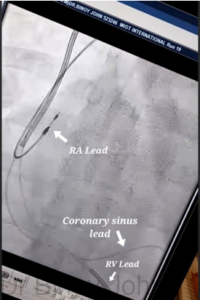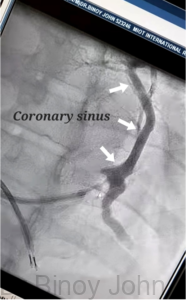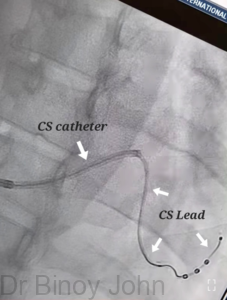What is Cardiac Re-synchronization therapy (CRT)?
Cardiac Re-synchronization therapy is a complex procedure performed in heart-failure patients with severe pumping failure of the left ventricle (LV). The normal pumping function or ejection fraction of the heart or left ventricle is 55-70% at rest.
What is heart failure?
The function of the heart is to pump blood forward. For the heart or left ventricle to work as an efficient pumping chamber,all the walls of the LV have to contract together as a single unit. In heart-failure, in some cases, this unison may be lost and when one segment or wall of the left ventricle contracts the other may not and may move away, causing a reduction in the pumping efficiency. (See: Section on Heart-failure)
Heart failure can occur from numerous causes. Heart attacks or ischemic heart disease is the commonest cause. With prolonged survival of heart-attack patients, achieved from angioplasty and stenting, by-pass surgery and advanced cardiac medical care, with increasing age there are more and more patients ending up with heart-failure as a part of normal progression.
Repeated hospitalizations and increased frequency of hospitalization are the burden and challenges faced by the patient, family and the treating cardiologist.
How can heart-failure be managed?
Heart-failure to an extent can be managed with medications, but with progression of HF with time and with advanced heart-failure, the doses of medications will reach a point when it cannot be increased any further.
Heart-transplantation is the gold standard in treatment of heart-failure. However heart transplantation is not a viable option in many patients who seek medical help late and also due to lack of easy availability of hearts and also due to high costs involved. In patients whom heart transplantation is not possible or while they wait to receive hearts from matched donors, there are several options of treatment with devices, called Bridge to transplant, like Cardiac Re-synchronization Therapy (CRT) and Ventricular Assist Devices (VAD). These devices improve the quality of life in these patients with cardiac pump-failure and pumping efficiency less than 30 – 35% who develop increasing breathlessness with activities and reaching a point when breathlessness is present even at rest or lying down, so much so that no activity is possible by them without breathing difficulty.
What is Cardiac Re-synchronization Therapy (CRT)?
Normally the heart walls of the left ventricle, contract as a single unit, but with heart-failure setting in, in some patients, when one wall or segment contracts, the other wall moves away, thereby decreasing the pumping efficiency. This dys-synchrony in contraction of the walls can in certain cases be corrected by CRT, where in addition to the two leads used in a Permanent Pacemaker Implantation (See Pacemaker) in the right ventricle and right atrium, a third lead is placed in the vein of the heart called the coronary sinus, usually the lateral most branch, which lies close to the wall that moves away when the heart contracts. The device or pulse generator on to which the leads are connected is programmed in such a way that the impulse is conducted to the dys-synchronous wall and makes it to contract in unison with the other walls in synchrony, thereby improving the pumping efficiency of the left ventricle and heart. This treatment where the synchrony in conduction is re-introduced is called Cardiac Re-synchronization Therapy (CRT). This treatment helps in improving the symptoms and the quality of life of the patient.
CRT device has two variants. The CRT-D and CRT-P. In the CRT-D variant there is a defibrillation coil in the lead placed inside the RV, just as in an ICD (See ICD) which gives the added benefit of preventing sudden cardiac death, by shocking the heart from inside, when an otherwise fatal ventricular arrhythmia occurs. If not shocked immediately heart-failure patients can die immediately called sudden cardiac death. CRT-P variant has only a pacemaker function (See section on Pacemaker) and not the de-fibrillator function
Heart-transplantation is however the gold standard treatment for heart-failure patients, but CRT provides an intermittent treatment while the patient waits for a donor heart and so CRT is labelled as a ‘Bridge to transplant’ procedure.
The procedure involves the placement of three leads or electrical wires inside the heart. The initial steps of anaesthesia, incision below the collar bone, (See image) and surgical pocket creation are similarto that for a Dual chamber Pacemaker implantation and or Implantable Cardioverter Defibrillator implantation. (See corresponding sections). However CRT is often done under deep sedation and the surgical incisions are a little longer as the device is bulkier.

The placement of RV and RA leads are also exactly in the same manner as for PPI and ICD. (See image)

The third lead is the coronary sinus lead which is placed inside the coronary sinus which is the vein of the heart. (See image)

The CS lead is placed in an appropriate branch of the CS via a specialized sheath (See image) called CS Catheter.

Thereafter, the opposite ends of all three leads are connected to the CRT pulse generator. (See image)

After checking all parameters the PG is secured via sutures and the surgical wound is closed in layers as for PPI and ICD implantation. (See corresponding sections for details)
Watch:
Video shows CRT-D done by me in 2018 in a 34 years old patient from Kenya who was shifted to my care with severe breathlessness, fluid in the lungs, swelling of his legs, congestive failure and jaundice and a LV pumping of 25%. He was initially treated medically for a month with intra-venous medications and heart-failure tablets for the jaundice and swelling to resolve and for stabilization. Thereafter I performed the CRT-D and the patient had significant improvement of symptoms and was discharged in a couple of days.
Expertise: Dr Binoy John is an expert in the management of advanced heart-failure, and had done a two month training in Advanced Heart-failure and Cardiac Transplant Medicine at Cedars Sinai Medical Centre, Los Angeles, U.S.A and is experienced in CRT and other Bridge to Heart Transplant therapy and medical management of advanced heart-failure.






